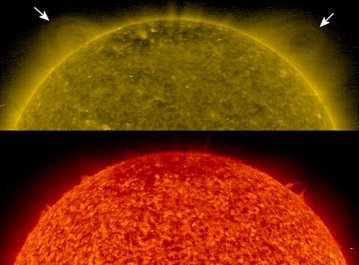Mission statement: An
international multi-instrument airborne campaign to monitor the safe
reentry of ESA's new Automated Transfer Vehicle over the south Pacific
ocean during its maiden voyage in 2008.
News
2008 September 18 - The arrival of funding at NASA Ames
Research Center for the ATV-1 "Jules Verne" MAC mission was celebrated
this morning. The remaining significant hurdles appear to have been
resolved. We thank all involved that made this possible behind the
scenes. Next week, the focus will shift to setting up and testing the
instruments on the aircraft, for departure on Friday September 26

https://atv.seti.org/
~~~~~~~~~~~~~~~~~~~~~~~~~~~~~~~~~~~~~~~
MICKEY MOUSE EARS: Ultraviolet photos taken by the Solar and
Heliospheric Observatory (SOHO) reveal the a strange pair of "Mickey
Mouse" ears on the sun. They've been sighted many times in
recent weeks and are especially prominent today:

What are they? Coronal
cavities--regions of low density, high temperature gas contained
by loops of magnetic field. Coronal cavities are where prominences
are born. Indeed, there is a prominence inside the righthand cavity;
look for it in the red image, above, also from SOHO.
There's more to this story. The two ears appear to
be two distinct cavities. In fact, they are one. The actual cavity
is a collosal ring encircling the north pole of the sun. Geometrically,
it is similar to the auroral
ovals of Earth. The two ears are cross-sections of the translucent
ring, distinctly visible because they hang out over the edge of
the solar disk.
The ring-shaped cavity is also known as the sun's
"polar crown" and it spawns some truly
beautiful prominences. The polar crown is easiest to see during
solar minimum when the sun is not cluttered with spots--so now is
the perfect time. Look for the ears in daily
images from SOHO.
~~~~~~~~~~~~~~~~~~~~~~~~~~~~~~~~~~~~~~~~~~~~~
CERN update
GENEVA (AFP) - The world's largest particle collider was running again
Friday after an electrical fault forced it to stop just days after
being launched to global fanfare, the European Organisation for Nuclear
Research (CERN) said.
The problem affected a cooling system for high-powered magnets designed to steer beams of particles around the Large Hadron Collider's 27-kilometre (16.9-mile) circular tunnel, CERN said.
CERN spokesman James Gillies told AFP a 30-tonne transformer in the
cooling system failed Thursday last week and it had taken about a week
to replace the equipment and get temperatures back to their required
state.
The steering magnets in the LHC tunnel are chilled to as low as
-271 degrees Celsius (-456.25 degrees Fahrenheit), which is close to
absolute zero and colder than deep outer space.
"In layman's terms, the LHC is a great big fridge, and part of the power supply failed," he said.
The LHC took nearly 20 years to complete and at six billion Swiss francs (3.76 billion euros, 5.46 billion dollars) is one of the costliest and most complex scientific experiments ever attempted.
It aims to resolve some of the greatest questions surrounding
fundamental matter, such as how particles acquire mass and how they
were forged in the "Big Bang" that created the Universe some 13.7
billion years ago.
The September 10 switch-on saw the testing of a clockwise beam, and
then an anticlockwise beam. The first collisions are not expected for a
number of weeks, given the long process of testing the LHC's equipment.
Gillies said that despite the setback, the LHC was not behind schedule.
~~~~~~~~~~~~~~~~~~~~~~~~~~~~~~~~~~~~~~~~~~~
Large Hadron Collider suffers glitch within hours of launch
The
Large Hadron Collider, the world's largest particle collider,
malfunctioned within hours of its launch, but its operator did not
report the problem for a week. By Chris Irvine.
The CERN have now replaced the faulty transformer and the ring in the 17-mile circular tunnel under the Swiss-French border. It has also now been cooled back down to near zero on the Kelvin scale When the transformer malfunctioned, Steve "It's a real challenge requiring incredible talent, brain power and coordination to get it running." Fermilab, in Illinois, is home to the Tevatron, an accelerator that Judith The Large Hadron Collider is designed The 10th of September switch-on saw the testing of a clockwise beam, and then an anticlockwise beam, Now https://www.telegraph.co.uk/earth/main.jhtml?view=DETAILS&grid=&xml=/earth/2008/09/19/scilhc119.xml |


